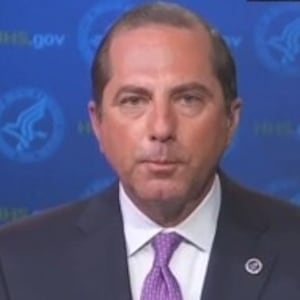Weeks into the national lockdown, the Canterbury Rehabilitation and Healthcare Center outside Richmond had become the site of one of the nation’s worst localized outbreaks of COVID-19, with 45 residents dead of COVID-19 in a little over a month.
“A publicly funded nursing home is a virus’ dream,” Dr. Jim Wright, the chief medical officer at Canterbury, said at the time. “People are close together, their immune systems are compromised—it is just a tinder box for that match.”
By April 13, Rep. Abigail Spanberger (D-VA), who represents the area, was on MSNBC explaining what nursing homes like Canterbury needed—namely, a whole lot of federal relief money, and fast, so that facilities could stock up on COVID-19 tests to help identify outbreaks, personal protective equipment for caregivers, and funds to hire additional staff as existing ones fell ill or left.
ADVERTISEMENT
But by May, the needed relief had still not arrived and the Department of Health and Human Services has not still not clearly explained to Spanberger and her colleagues why the billions of dollars set aside for nursing home relief in the CARES Act, the $2.2 trillion COVID-19 response legislation that passed on March 27, was not immediately distributed.
It was only last week that HHS announced it was beginning to direct $4.9 billion in relief toward the country’s nursing homes—a sum that lawmakers like her believe amounts barely to a down payment in addressing urgent problems, like providing the level of testing that’s needed and securing adequate PPE and staffing.
“It’s tremendous, the gap between $4.9 billion spread across eligible facilities and the actual need,” Spanberger told The Daily Beast. “These are not limitless funds, but many people agree that $4.9 billion is far less than it should be.”
A bipartisan group of members of Congress have urged HHS to make at least $25 billion—out of the $175 billion health-care fund set up in COVID legislation—available to a broad range of nursing homes and long-term care facilities. So far, Spanberger said that she’s not received any indication of when HHS might move on releasing more money for nursing homes, among other things, and described her communication with the agency as “a little bit like a one-sided pen pal relationship.”
In the meantime, death tolls continue to mount at nursing homes around the country, with 42 percent of all COVID-19 deaths in the U.S.—over 40,000—coming from facilities that care for the elderly. The industry itself is struggling, and smaller operators could face insolvency in the near future unless they get relief from the government, according to experts in the field.
Though the coronavirus outbreak has overstretched a federal government now forced to confront an untold number of new, life-threatening emergencies, some lawmakers and advocates have been baffled at the slow pace of the administration’s response to COVID-19’s uniquely lethal impact on nursing homes. The first major U.S. outbreak of the disease, in February, was at a nursing home in Washington state—an early sign that the illness could spread rapidly in facilities crowded with the elderly.
That essential funding for those facilities would take such a long time to get out the door, say some experts, is tantamount to a failure of leadership from the Trump administration. “The administration has had no clue what it's doing in regard to older adults and long-term care,” says Michael Wasserman, director of nursing home patient safety for the California Association of Long-Term Care Medicine, a professional group for health care providers.
Though there are “really good people” working at agencies like the Centers for Disease Control and Prevention, Wasserman says the onus falls squarely on leadership at those agencies and at the White House. “I’m worried the administration is just completely blind to what’s going on in nursing homes and has not been focused whatsoever on effectively dealing with it.”
Publicly, officials from the administration have acknowledged the need to direct funding from the CARES Act to nursing homes as outbreaks in those facilities worsened over the month of April. On April 22, HHS Secretary Alex Azar said “there are still some providers” who need special help. “Skilled nursing facilities, for instance, need funds both as part of our general provider compensation efforts and because they are suffering particular costs from COVID-19,” he said.
A month later, on May 22, Azar announced the release of $4.9 billion to nursing facilities. “This funding secured by President Trump will help nursing homes keep the seniors they care for safe during the COVID-19 pandemic,” said Azar. “The Trump Administration is providing every resource we can, from funding and direct PPE shipments to regulatory flexibility and infection control consultations, to protect seniors in nursing homes and those who care for them.”
In that release, HHS said that impacted facilities would all see a fixed $50,000 relief sum and then an additional $2,500 for each bed in the facility. Nursing homes would have to certify they only use the funds for approved purposes, like procuring PPE and shoring up staffing levels.
In response to a request for comment from The Daily Beast, an HHS spokesperson said that the department “acted swiftly to deliver urgently needed funding to our frontline healthcare providers,” noting that nursing homes were eligible for some $62 billion in relief alongside hospitals, clinics, and other health care providers. HHS, said the spokesperson, has been “transparent and upfront” about getting funds more immediately to facilities that depend less on revenue from Medicare and Medicaid payments, like many nursing homes do. With respect to its communication with lawmakers, the spokesperson said HHS continues to “maintain an open line of communication with Members of Congress, including holding briefings for members of both the House and Senate and working with members on a daily basis, while helping coordinate the response to the public health emergency.”
To be sure, lawmakers and experts are relieved to see the funding make its way to nursing homes. But the initial amount distributed by HHS—and the way it’s being distributed—doesn’t seem to square with the scale of the basic tasks that these facilities will have to accomplish if they’re to contain outbreaks and save lives. Industry groups have laid out $10 billion as a sum that could meet basic benchmarks on testing, for example.
“Let’s say it’s enough to cover testing people once for a limited period of time—that’s a great start,” said Tamara Konetzka, a public health professor at the University of Chicago who testified before the Senate in April about the challenges facing nursing homes. “But we know a couple of things about testing: there’s a high false negative rate, and if you test them once, you have to re-test them.”
“I think there has been a slowness, a reluctance, on the part of everybody to recognize how serious this problem is in nursing homes,” Konetzka told The Daily Beast, saying the federal government “has not been able to implement policy quickly and effectively during this pandemic.”
Meanwhile, the nursing home industry has been transformed by the COVID-19 pandemic—and the wrenching changes have left many companies on the brink of financial collapse even as they care for patients, making federal aid all the more important.
Nursing homes face an unprecedented squeeze on both sides of the ledger, explained David Grabowski, a professor of health-care policy at Harvard Medical School. They are dependent on payments from government-run Medicare and Medicaid programs, but those two programs operate differently. Medicare pays a generous rate for short-term stays in facilities for patients who are coming to recuperate after surgeries and other procedures, while Medicaid pays a lower rate for long-term nursing home residents, who may stay there for the duration of their lives.
“This model is nearly impossible in the context of COVID,” said Grabowski. “Hospitals are no longer doing elective procedures like hip and knee replacements. Thus, the short-stay revenue for nursing homes has largely dried up. In the meantime, nursing home costs have increased due to personal protective equipment, hazard pay, and other COVID-related costs. Less revenue and higher costs is not a winning combination.”
Even the largest and best-resourced companies in the sector are facing serious financial shortfalls. Genesis, the nation’s largest nursing home operator, has received some $300 million in relief cash from the federal government so far. There are nearly 7,000 cases of COVID in its facilities and its operating expenses rose an additional $21 million in April, the New York Times reported Wednesday.
But it’s the smaller facilities—family-owned and nonprofit—that are more immediately staring down financial pain and insolvency, say experts. Wasserman told The Daily Beast that the COVID-19 pandemic could “decimate” the elder care industry and that he expected a wave of closures in six to 12 months, chiefly among smaller facilities that don’t have the option to stay afloat by selling off real estate holdings, like Genesis did amid the pandemic.
Lawmakers and experts have raised questions about HHS’s funding distribution mechanisms, which they worry could disadvantage the smaller and not-for-profit nursing facilities that operate in rural and underserved areas.
“COVID has been particularly hard on smaller, lower resource facilities,” said Grabowski. “I have also heard complaints that smaller facilities have not received as much of the funds as some of the larger chains. However, this is really anecdotal because the administration hasn’t been very transparent as to the distribution of funds.”
Officials have tried to convey transparency, according to some involved in the issue. After her April 13 MSNBC appearance, Spanberger got a call from the administration asking if she would be interested in speaking with Seema Verma, the administrator of the federal Centers for Medicare and Medicaid Services.
The congresswoman said she had a productive conversation with Verma but ultimately “it didn’t put us on a path toward nursing homes and long-term care facilities getting what it is they need.”
Going forward, Spanberger and a group of Democratic lawmakers have asked HHS officials to provide a briefing for members of Congress about how they’re approaching support for nursing homes. The outbreak at the Canterbury facility near Richmond has, thankfully, abated. But “it’s only a matter of time that other communities are impacted the way our community has been impacted,” said Spanberger.
“I could tick off probably a hundred different things we should have done differently in the way we handled this crisis,” she said. “At this stage… the disappointment has been the type of responses I’ve received from HHS. It continues to disappoint because there’s no clear, direct path, or plan. So much of it comes down to, if this were made a priority, we could make this better.”
Updated to add comment from an HHS spokesperson.







